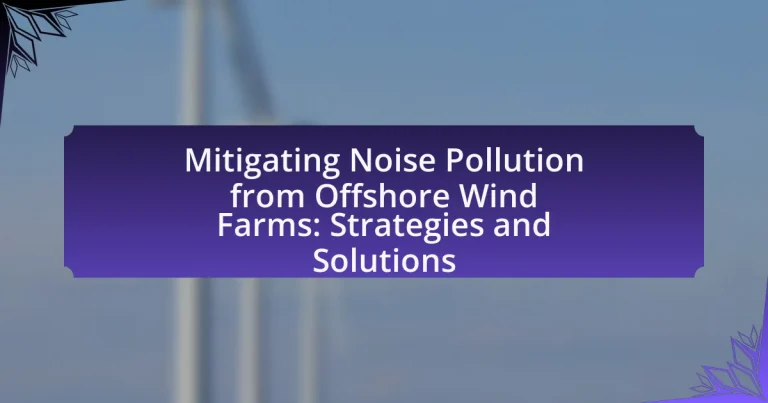Noise pollution from offshore wind farms is a significant environmental concern, primarily arising from the underwater and airborne sounds produced during the construction, operation, and decommissioning of wind turbines. This article examines the impact of noise pollution on marine life, particularly species that rely on sound for communication and navigation, such as whales and dolphins. It discusses the specific species affected, the disruption of marine ecosystems, and the importance of mitigating noise pollution to protect both human health and wildlife. Additionally, the article outlines current strategies and technologies employed to reduce noise levels, regulatory measures in place, and future solutions for effective noise management in offshore wind energy production.
What is Noise Pollution from Offshore Wind Farms?
Noise pollution from offshore wind farms refers to the underwater and airborne sounds generated during the construction, operation, and decommissioning of wind turbines. These sounds can disrupt marine life, particularly species that rely on echolocation and communication, such as dolphins and whales. Studies indicate that construction activities, including pile driving, can produce noise levels exceeding 200 decibels, which can have detrimental effects on marine ecosystems. Additionally, operational noise from turbine blades can contribute to both underwater and above-water soundscapes, potentially affecting wildlife behavior and habitat use.
How does noise pollution impact marine life?
Noise pollution significantly impacts marine life by disrupting communication, navigation, and predator-prey interactions among aquatic species. Marine animals, such as whales and dolphins, rely on sound for essential behaviors, including mating and foraging. Increased noise levels from human activities, including offshore wind farms, can lead to stress, disorientation, and even strandings in sensitive species. Research indicates that chronic exposure to elevated noise levels can result in decreased reproductive success and altered migration patterns, as evidenced by studies showing that noise interferes with the echolocation abilities of marine mammals.
What specific species are affected by noise pollution?
Noise pollution specifically affects marine species such as whales, dolphins, and fish. Research indicates that these species experience disruptions in communication, navigation, and feeding due to elevated noise levels from human activities, including offshore wind farms. For instance, studies have shown that increased underwater noise can lead to stress responses in marine mammals, impacting their behavior and potentially leading to population declines.
How does noise pollution disrupt marine ecosystems?
Noise pollution disrupts marine ecosystems by interfering with the communication, navigation, and feeding behaviors of marine species. For instance, many marine animals, such as whales and dolphins, rely on echolocation and vocalizations for navigation and social interactions. Increased underwater noise from human activities, including shipping and construction, can mask these sounds, leading to disorientation and stress in these species. Research indicates that chronic noise exposure can result in altered behaviors, reduced reproductive success, and even strandings, as documented in studies like the one conducted by the National Oceanic and Atmospheric Administration, which highlights the detrimental effects of noise on marine life.
Why is it important to mitigate noise pollution?
Mitigating noise pollution is important because it protects human health and preserves wildlife ecosystems. Excessive noise can lead to various health issues, including stress, sleep disturbances, and cardiovascular problems, as evidenced by studies indicating that prolonged exposure to noise levels above 55 decibels can significantly increase the risk of these health conditions. Additionally, noise pollution adversely affects wildlife, disrupting communication, mating, and feeding behaviors, which can lead to population declines. Research has shown that marine mammals, for instance, experience disorientation and stress due to underwater noise, impacting their survival. Therefore, addressing noise pollution is crucial for safeguarding both human well-being and environmental integrity.
What are the potential long-term effects of unmitigated noise pollution?
Unmitigated noise pollution can lead to significant long-term effects on human health and the environment. Chronic exposure to high noise levels is associated with increased risks of cardiovascular diseases, sleep disturbances, and cognitive impairments, as evidenced by studies indicating that noise pollution can elevate stress hormone levels and disrupt normal sleep patterns. Additionally, wildlife is adversely affected, with research showing that persistent noise can interfere with animal communication, reproduction, and foraging behaviors, ultimately threatening biodiversity.
How does noise pollution affect human activities near offshore wind farms?
Noise pollution from offshore wind farms negatively impacts human activities by disrupting fishing, recreational boating, and marine tourism. The underwater noise generated during construction and operation can interfere with the communication and navigation of marine species, which in turn affects fishing yields and the overall marine ecosystem. Studies indicate that increased noise levels can lead to a decline in fish populations, as species such as cod and haddock are sensitive to sound. Additionally, recreational activities like boating may be deterred due to the perceived disturbance, leading to reduced economic benefits for local communities reliant on tourism.
What strategies are currently used to mitigate noise pollution?
Strategies currently used to mitigate noise pollution from offshore wind farms include the implementation of noise-reducing technologies, careful site selection, and operational management practices. Noise-reducing technologies, such as specialized turbine designs and sound-absorbing materials, help minimize the sound generated during operation. Site selection involves placing wind farms in locations that are less likely to impact sensitive marine habitats or human populations, thereby reducing potential noise exposure. Additionally, operational management practices, such as limiting construction activities to specific times and using quieter equipment, further contribute to noise reduction. These strategies are supported by research indicating that effective noise management can significantly lower the impact of offshore wind farms on marine life and nearby communities.
How effective are current noise reduction technologies?
Current noise reduction technologies are highly effective in mitigating noise pollution from offshore wind farms. These technologies, such as advanced acoustic barriers, noise-absorbing materials, and innovative turbine designs, can reduce underwater and airborne noise levels significantly. For instance, studies have shown that using specialized turbine designs can lower noise emissions by up to 10 decibels, which corresponds to a 50% reduction in perceived loudness. Additionally, the implementation of noise mitigation strategies, like the use of bubble curtains during construction, has been proven to decrease noise levels by approximately 20-30 decibels in marine environments. This effectiveness is crucial for protecting marine life and maintaining compliance with environmental regulations.
What types of technologies are employed in offshore wind farms?
Offshore wind farms employ several key technologies, including wind turbines, subsea cables, and monitoring systems. Wind turbines, specifically designed for marine environments, are typically larger and more robust than their onshore counterparts, allowing them to harness wind energy efficiently. Subsea cables are used to transmit the generated electricity back to the shore, ensuring minimal energy loss during transmission. Additionally, advanced monitoring systems are implemented to track environmental conditions and operational performance, which can help in mitigating noise pollution by optimizing turbine operation and maintenance schedules. These technologies collectively enhance the efficiency and sustainability of offshore wind energy production.
How do these technologies specifically reduce noise levels?
Technologies such as noise barriers, sound insulation, and advanced turbine designs specifically reduce noise levels by minimizing sound transmission and altering sound propagation. Noise barriers absorb and deflect sound waves, effectively reducing the noise that reaches surrounding areas. Sound insulation materials, when used in turbine construction, dampen vibrations and prevent sound from escaping. Additionally, advanced turbine designs, including quieter blade shapes and optimized operational settings, lower the overall sound output during operation. Research indicates that these strategies can reduce noise levels by up to 10 decibels, significantly mitigating the impact of offshore wind farms on marine and coastal environments.
What regulatory measures are in place to control noise pollution?
Regulatory measures to control noise pollution include the implementation of noise ordinances, environmental impact assessments, and specific guidelines for industries, particularly those related to construction and transportation. Noise ordinances set permissible noise levels and times for various activities, while environmental impact assessments evaluate potential noise impacts before project approvals. Additionally, industries are often required to follow guidelines established by agencies such as the Environmental Protection Agency, which provide standards for noise emissions and mitigation strategies. These measures aim to protect public health and the environment by minimizing excessive noise exposure.
What are the key regulations governing offshore wind farm operations?
The key regulations governing offshore wind farm operations include the Renewable Energy Directive, the Marine and Coastal Access Act, and the Environmental Impact Assessment Directive. These regulations establish frameworks for permitting, environmental protection, and operational standards. For instance, the Renewable Energy Directive mandates member states to promote renewable energy sources, including offshore wind, while the Marine and Coastal Access Act provides guidelines for marine licensing and management of marine resources. The Environmental Impact Assessment Directive requires comprehensive assessments of potential environmental impacts before project approval, ensuring that noise pollution and other ecological concerns are addressed.
How do these regulations vary by region?
Regulations regarding noise pollution from offshore wind farms vary significantly by region, reflecting local environmental policies and stakeholder interests. For instance, in Europe, countries like Germany and the Netherlands have established stringent noise limits and monitoring requirements to protect marine life, while the United States has a more fragmented regulatory approach, with states like Massachusetts implementing specific guidelines, but lacking a unified federal standard. Additionally, regions such as the Baltic Sea have unique regulations that consider the ecological sensitivity of the area, emphasizing the need for tailored approaches based on local conditions and environmental impacts.
What are the future solutions for mitigating noise pollution?
Future solutions for mitigating noise pollution from offshore wind farms include the development of quieter turbine designs, the implementation of noise-reducing technologies, and strategic site selection. Quieter turbine designs, such as those utilizing advanced blade shapes and materials, can significantly reduce operational noise levels. Noise-reducing technologies, including sound barriers and dampening systems, can further minimize the impact of noise on marine life and nearby communities. Additionally, selecting sites that are farther from sensitive habitats and populated areas can help mitigate the effects of noise pollution. These strategies are supported by research indicating that innovative turbine technology and careful planning can effectively reduce noise emissions associated with offshore wind energy production.
How can innovative designs contribute to noise reduction?
Innovative designs can significantly contribute to noise reduction by incorporating advanced materials and structural modifications that dampen sound transmission. For instance, the use of noise-absorbing materials in the construction of wind turbine components can minimize the vibrations that generate noise. Research indicates that implementing aerodynamic blade designs can reduce turbulence and, consequently, the noise produced during operation. A study by the National Renewable Energy Laboratory found that optimizing blade shape and using composite materials can lead to a reduction in noise levels by up to 10 decibels. These design strategies not only enhance the performance of offshore wind farms but also address community concerns regarding noise pollution.
What are some examples of innovative turbine designs?
Some examples of innovative turbine designs include the Siemens Gamesa SG 14-222 DD, which features a larger rotor diameter and increased efficiency, and the Vestas V236-15.0 MW, designed for high energy output with reduced noise levels. These designs incorporate advanced materials and aerodynamic shapes to enhance performance and minimize environmental impact, particularly in offshore settings. The Siemens Gamesa turbine, for instance, has a rotor diameter of 222 meters, allowing for greater energy capture while operating at lower noise levels, which is crucial for mitigating noise pollution in marine environments.
How do these designs minimize noise production?
These designs minimize noise production by incorporating advanced engineering techniques such as noise-reducing turbine blade shapes and optimized operational protocols. The aerodynamic design of turbine blades reduces turbulence, which is a primary source of noise, while operational strategies, like adjusting the pitch of blades and limiting operational speeds during sensitive periods, further decrease sound emissions. Studies have shown that these modifications can lead to a significant reduction in underwater and airborne noise levels, thereby mitigating the impact on marine life and surrounding communities.
What role does research and development play in future strategies?
Research and development (R&D) is crucial in shaping future strategies for mitigating noise pollution from offshore wind farms. R&D enables the identification and implementation of innovative technologies and methodologies that can effectively reduce underwater and airborne noise generated by wind turbines. For instance, advancements in turbine design, such as the development of quieter blade shapes and materials, have been shown to significantly decrease noise levels. Additionally, R&D facilitates the exploration of noise mitigation techniques, such as the use of sound barriers or the strategic placement of turbines to minimize impact on marine life. These efforts are supported by studies indicating that effective R&D can lead to a reduction in noise pollution, thereby enhancing environmental sustainability and compliance with regulatory standards.
What ongoing research is focused on noise pollution mitigation?
Ongoing research focused on noise pollution mitigation from offshore wind farms includes studies examining the effectiveness of noise reduction technologies and strategies. For instance, the project “Reducing Underwater Noise from Offshore Wind Farms” led by the University of Exeter investigates methods to minimize noise generated during construction and operation phases. This research aims to develop best practices and technologies that can significantly lower the impact of noise on marine life, particularly focusing on the use of noise barriers and quieter construction techniques. Additionally, the European Union’s Horizon 2020 program funds various initiatives aimed at understanding and mitigating the acoustic impacts of offshore wind energy, emphasizing the importance of sustainable development in marine environments.
How can collaboration between industries enhance solutions?
Collaboration between industries can enhance solutions by pooling resources, expertise, and innovative technologies to address complex challenges like noise pollution from offshore wind farms. For instance, partnerships between renewable energy companies, marine biologists, and acoustic engineers can lead to the development of quieter turbine designs and effective noise mitigation strategies. Research indicates that interdisciplinary collaboration can accelerate problem-solving and lead to more sustainable practices, as seen in projects where shared knowledge has resulted in reduced environmental impacts and improved regulatory compliance.
What best practices can be implemented for noise pollution mitigation?
Best practices for noise pollution mitigation include implementing noise barriers, utilizing quieter machinery, and scheduling construction activities during off-peak hours. Noise barriers, such as earth mounds or sound-absorbing panels, effectively reduce sound transmission from offshore wind farms to nearby communities. Quieter machinery, including advanced turbine designs and low-noise construction equipment, minimizes operational noise. Scheduling construction activities during times when fewer people are affected, such as nighttime or weekends, further decreases noise impact. These strategies are supported by studies indicating that effective noise management can significantly lower community disturbance and enhance public acceptance of offshore wind projects.
How can offshore wind farm operators adopt effective noise management strategies?
Offshore wind farm operators can adopt effective noise management strategies by implementing advanced turbine designs that minimize noise generation and utilizing noise mitigation technologies during construction and operation. Research indicates that using larger rotor diameters and slower rotational speeds can significantly reduce aerodynamic noise, while sound-absorbing materials can be applied to turbine structures to dampen noise levels. Additionally, operators can schedule construction activities during periods of lower marine activity to minimize disturbances to marine life, as studies show that noise pollution can adversely affect marine species, particularly during critical life stages.
What community engagement practices can help address noise concerns?
Community engagement practices that can help address noise concerns include public forums, stakeholder meetings, and collaborative decision-making processes. These practices facilitate open dialogue between offshore wind farm developers and local communities, allowing residents to express their concerns and preferences regarding noise levels. Research indicates that involving the community in the planning stages can lead to more acceptable solutions and increased trust in the developers. For instance, a study by the National Renewable Energy Laboratory found that community involvement in project design significantly reduced opposition to wind farm developments.




